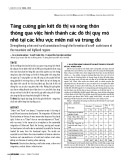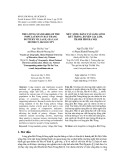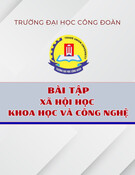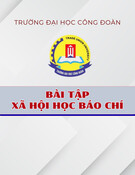
http://www.iaeme.com/IJMET/index.asp 1837 editor@iaeme.com
International Journal of Mechanical Engineering and Technology (IJMET)
Volume 10, Issue 03, March 2019, pp. 1837–1849, Article ID: IJMET_10_03_186
Available online at http://www.iaeme.com/ijmet/issues.asp?JType=IJMET&VType=10&IType=3
ISSN Print: 0976-6340 and ISSN Online: 0976-6359
© IAEME Publication Scopus Indexed
PUBLIC SERVICE INNOVATION MODEL IN
INDONESIA: A CASE STUDY OF KOLAKA
REGENCY, SOUTHEAST SULAWESI
Abdul Kadir, La Ode Muhamad Umran, Harnina Ridwan, Samiruddin T
Halu Oleo University, Kendari, Indonesia
Udin Udin*
Diponegoro University, Semarang, Indonesia
* Corresponding Author
ABSTRACT
Innovation in the field of state administration is essentially the development of best
practices or applications of institutions, apparatus, governance, and public services to
improve systems to provide added value. Innovation is needed to accelerate the
modernization or reform the effective, responsive and accountable state administration.
Public service innovation in Kolaka regency, Southeast Sulawesi Province - Indonesia
places more emphasis on the vision of innovation in governance, commitment to
changes, rewards for innovators, innovation drivers, innovative human resource
capability, human resource awareness of innovation, develop3ment innovative human
resources, budget support for public service innovation, optimization of corporate
social responsibility (CSR) to support innovation, and the use of information technology
in work systems.
Key words: Innovation, Public Service
Cite this Article: Abdul Kadir, La Ode Muhamad Umran, Harnina Ridwan,
Samiruddin T and Udin Udin, Public Service Innovation Model in Indonesia: A Case
Study of Kolaka Regency, Southeast Sulawesi, International Journal of Mechanical
Engineering and Technology 10(3), 2019, pp. 1837–1849.
http://www.iaeme.com/IJMET/issues.asp?JType=IJMET&VType=10&IType=3
1. INTRODUCTION
Public services have a very important role related to the public interest, even the interests of the
people as a whole. Services can be said as the key to the success of various service businesses.
According to Mahmudi (2007), public services are all service activities carried out by public
service providers as an effort to fulfill public needs. The amount of public demand for the
government to continue the improvement of service quality is felt as a very urgent need.
Functionally, the implementation of public services is a form of government obligation to
society.

Public Service Innovation Model in Indonesia: A Case Study of Kolaka Regency, Southeast Sulawesi
http://www.iaeme.com/IJMET/index.asp 1838 editor@iaeme.com
The government system is regulated in Law No. 32 of 2004 undergoing revisions to the
Second Amendment to the Law of the Republic of Indonesia No. 12 of 2008 concerning
Amendments to Regional Government. Local governments are given the authority to organize
their own government to more responsive to the needs and aspirations of the society. In granting
authority to the regions, especially to the regency / city, government refers to the principle of
regional autonomy. Regions are given the authority to manage and regulate the affairs. As Elmi
stated in Khusaini (2002) that decentralization means giving part of the authority of the central
government to the regions to carry out and settle matters that are the responsibility and concern
the interests of the region. The authority possessed by the regions is to make regional policies
to provide public services, increase roles, initiatives and community empowerment aimed at
improving people's welfare.
Referring to the purpose of the public service law (No. 25 of 2009), the implementation of
public services must know their obligations and responsibilities for activities involving services
to the public. In realizing public services, the most important aspect is the movement to
implement bureaucratic reform with the aim of achieving good governance. Bureaucratic
reform in Indonesia places a priority on bureaucratic rationalization in order to create
effectiveness and productivity through a comparable division of labor, which measured by the
ratio between task load and the amount of resources accompanied by formalistic work
procedures and close supervision.
The objective of the Indonesian bureaucracy reform policy is to develop the attitude of the
apparatus, profiles and behavior who have integrity, productivity, high dedication,
responsibility and ability to provide excellent service through changes in mindset and work
culture in government management systems so that public servants are carried out the
government is optimal. The results of a survey conducted by several institutions, Indonesia still
needs to improve public services to face the MEA. The Political Economic Risk Consultancy
(PERC) places Indonesia under Vietnam, Philippines, Thailand, Malaysia, Taiwan, South
Korea, Macau, Japan, Hong Kong, and Singapore with a score of 9.27 on a scale of 0-10.
Meanwhile, International Finance Cooperation (IFC) in 2013 ranked Indonesia as 120th out of
180 countries. The Global Competitiveness Report Index places Indonesia ranked 34 out of 144
countries. At the ASEAN level, Indonesia is still under Singapore, Malaysia and Thailand for
the Corruption Perception Index, which ranks 107 out of 175 countries.
There are several factors causing the low quality of public services in Indonesia, namely the
existence of a monopolistic context. In this case, because there is no competition from public
service providers, there is no strong drive to increase the amount, quality and even distribution
of services by the government. The government is concerned with increasing public servants
but still does not show satisfactory results. People still complain about the poor quality of public
services received.
With the issuance of a government regulation on guidelines for evaluating the
implementation of public services, regional governments make improvements to the quality of
public services, especially on the performance of government officials. The policy of
implementing the assessment guidelines for public service consists of 12 instruments. As public
servants, the authorities are expected to provide services that are fast, cheap, comfortable, and
safe as a form of accountability to the community so that good and clean governance will be
realized.
Accelerating the improvement of the quality of public services in the regency/ city
government requires a strong commitment, creativity, innovation, and breakthrough from the
mayor and all ranks to implement policies in the public services. The reality in some regions
where leaders and their staff have a strong commitment in efforts to improve the quality of
public services, has shown considerable progress. Meanwhile there are still many other regions

Abdul Kadir, La Ode Muhamad Umran, Harnina Ridwan, Samiruddin T and Udin Udin
http://www.iaeme.com/IJMET/index.asp 1839 editor@iaeme.com
that have not shown progress as expected. Based on experience, the existence of competition in
service units is one of the driving factors in motivating and improving the performance of these
service units. Therefore to improve the quality of public services in regencys/ cities, it is deemed
necessary to evaluate the performance of regency governments in the context of inter-regional
competition, including in Kolaka regency.
The Kolaka regency government is based on one of its missions by implementing good,
efficient, clean and dignified governance. This is in line with the central government, namely
creating good governance and realizing bureaucratic reform. The regional government is also
expected to carry out the implementation of the Minister of Administrative Reform and
Bureaucratic Reform Regulation No. 44 of 2011 concerning guidelines for assessing the
implementation of regency/ city government public service. The breakthrough of the Kolaka
regency government's mission is to improve the quality of public services, with the hope that
services are systematically by increasing the capability of government apparatus and
developing an effective, transparent, open, accountable, participatory, flexible and responsive
public service system to the needs of the community.
2. LITERATURE REVIEW
The good governance paradigm puts pressure on government management, including public
service management. The government is no longer positioned as a ruler with the nature of
hierarchical relations with the community, but as a partner with a hierarchical position with
other components (the private sector and society). The government is a public servant.
Government agencies are collective designations which include units of ministry
organizations, departments, and non-departmental government institutions. The secretariat of
the highest state institutions and other government agencies, both central and regional include
state-owned enterprises, state-owned legal entities, and regional-owned enterprises. According
to Kotler quoted by Soesilo Zauhar (1994), service is an activity or benefit offered by a party
to another that basically does not materialize and produce ownership. Moenir (2002) suggests
that a public service will be carried out well and satisfactorily if supported by several criteria,
namely:
Awareness of officials and officers involved
Rules that are the basis of work
Organizations that are tools and systems
Income that can meet the minimum living needs
Availability of facilities and infrastructure in accordance with the type of work
The ability and skills of the officer
Based on the description, service standards need to be carried out. Public service standards
are a standardized measure in the implementation of public services to adhered by providers.
According to Rowland quoted by Azwar (1996), service standards are specifications of
functions or objectives that must be met by a service facility so the users can get the maximum
benefit from services provided.
2.2. Construction of the Public Service Innovation Model
Innovation is a term and concept that has been widely discussed lately. Innovation is
increasingly trusted by many parties as the key to obtaining benefits in a broad scope, ranging
from individuals, communities, organizations, and countries. Innovation in the field of state
administration is essentially the development of best practices or applications in institutions,
apparatus, governance, and public services to create and improve systems to provide added

Public Service Innovation Model in Indonesia: A Case Study of Kolaka Regency, Southeast Sulawesi
http://www.iaeme.com/IJMET/index.asp 1840 editor@iaeme.com
value. Innovation is needed for effective, responsive and accountable of state administrative
reform. The implementation of public service innovations in Kolaka regency can be seen from
several aspects as follows:
2.1.1. Input of Public Service Innovation
Inputs in public service innovation in Kolaka regency include all resources such as policy,
leadership and HR, equipment support and technology, material, budget, and other inputs that
must be met to develop and produce regional innovations. The input in this study divides several
indicators used to look at the resources currently used in public services by the Kolaka regency
government. These indicators are such as vision of innovation, commitment to change, reward
for innovators, innovation driving policies, HR capability innovation, HR concern for
innovation, HR development innovation, budget support, CSR optimization in supporting
innovation, and IT use in work systems.
The vision of innovation is the commitment set by the Kolaka regency government in
improving and developing public services that are more effective and efficient in administering
the government. The description of the innovation vision that has been carried out by the Kolaka
regency government based on the results of 65.7% of the vision of innovation in the RPJMD
has been described in the work plan of all SKPDs, 20% vision of the RPJM has been described
in the roadmap, action plans, strategic plans and work programs of all SKPD, and 14.3% vision
of innovation and limited follow up. This shows that the description of the innovative vision of
the Kolaka regency government has been described in the work program of all government
official work units (SKPD). Therefore, the commitment of the regional leadership to organize
an effective and efficient government in public services in Kolaka regency has been carried out.
Commitment to change in the implementation of the Kolaka regency public service shows
that 58.6% of regional leaders have made continuous changes, 24.3% shows that regional
leaders have developed existing changes, 5.7% show that regional leaders have made changes
in their entirety and 11.4% shows that regional leaders have made partial changes. Thus, it can
be said that the regional leaders in Kolaka regency have committed to change public services
through public service innovations within the Kolaka regency government.
Reward for innovators is a form of appreciation given by the regional government to every
individual and government organization that can and has made innovations in the
implementation of public services in Kolaka regency. Through the provision of rewards it is
expected to motivate every individual and government organization to continue to create
innovations in the implementation of effective and efficient public services. The results of the
study relating to rewards for innovators showed that 52.9% of awards were given only to some
innovators, 12.9% of rewards were given to all innovators, 22.9% of rewards were given for
development for innovators, and 11.4% none rewards given to innovators. Based on the results
of the study, even though the vision of innovation and commitment to innovation already
existed from the regional leadership, the regional government has not fully given awards to
individuals and organizations that have produced innovations in public services within the local
government.
Optimizing public service innovations in Kolaka regency is carried out with the existence
of regional policies to encourage effective and efficient public service innovations. The policy
to encourage public service innovation in Kolaka regency shows that 58.6% have already had
regional head regulations to encourage innovation in public services, 18.6% have already set
up regional head regulations to encourage innovation in public services, 11.4% have already
had regional head regulations. (perkada) and regional regulations (perda) to encourage
innovation in public services, 5.7% have already been drafted by regional regulations (perda),
and 5.7% have no policies to encourage public service innovation. Based on the results of these
studies, it can be said that the policy of driving public service innovation has been in the form

Abdul Kadir, La Ode Muhamad Umran, Harnina Ridwan, Samiruddin T and Udin Udin
http://www.iaeme.com/IJMET/index.asp 1841 editor@iaeme.com
of regional head regulations (perkada) which are used to encourage innovations related to public
services within the scope of regional government. This is one form of commitment held by
regional leaders for better implementation of the Kolaka regency government, especially in
serving the Kolaka regency community.
Innovator HR capability shows that 58.6% of Human Resources (HR) in certain work units
already understand innovation, 31.4% of HR personnel in work units already understand
innovation and there are still 10.0% some already understand about innovation.
Related to budget support for innovation shows that 48.6% already have a budget to the
stage of implementation of innovation, 28.9% already have a budget at the stage of innovation
initiation and the rest there are still 22.9% of the budget until the development stage of
innovation.
Related to the optimization of CSR in supporting innovation shows that 48.9% of the
government initiated the exploration of the company's CSR (Corporate Social Responsibility),
25.7% have optimized CSR programs in limited innovation development and also 25.7% have
optimized CSR programs in develop innovation widely. While the use of IT in the work system
31.4% of the work system has been supported by widespread IT use, 30.0% in the work system
has been supported by IT use and towards Smart City, 24.3% of work systems have been
supported by IT use and further developed and 14.3% of work systems have been supported by
limited IT usage.
2.1.2. Process of Public Service Innovation
It is observed from the aspect of the process, in this study dividing several indicators that are
used to see the process currently carried out in public services by the Kolaka regency
government. These indicators include; socialization of innovation policies, technical guidance
/ advocacy / program assistance, development of innovations in RPJMD, innovation programs
and activities in SKPD Renstra, development of innovation networks, benchmarking to explore
ideas and ideas of innovation, and utilization of benchmarking results.
Socialization of innovation policy shows that there are 41.4% of the socialization of
innovation policies determined by the emergence of the idea of innovation, 35.7% of the
socialization of innovation policies have been scheduled for the dissemination of regional
innovation policies. Then, 17.1% of the socialization of innovation policies was initiated
through the planning of the agenda of activities and 5.7% of the socialization of regional
innovation policies became a routine agenda to maintain the spirit of innovation.
The implementation of the Bimtek / Advocacy / Mentoring Program showed that 45.7% of
the Bimtek/ Advocacy / mentoring of new regional innovation programs were initiated through
the planning of activity agendas, 28.6% had already been scheduled for regional innovation/
advocacy/ assistance programs and 25.7% showed that Furthermore, the results of technical
guidance/ advocacy/ regional innovation assistance can be seen from the emergence and
development of innovation ideas.
The development of innovation in the RPJMD shows that 54.3% have already put their
innovation development plan into the RPJMD on a limited basis, then 24.3% have initiated the
idea of developing innovation to be included in PRJMD, 15.7% have broadly developed
innovation plans into the RPJMD and the rest 5.7% have already poured an innovation
development plan into the RPJMD widely and are referred to by all SKPDs.
Innovation programs and activities in the SKPD Strategic Plan shows that 54.3% have
already poured innovation development plans into the RPJMD on a limited basis, then 24.3%
have initiated innovation development ideas to be included in the PRJMD, 15.7% have poured
plans to develop innovations into the RPJMD wide and the remaining 5.7% has already poured
an innovation development plan into the RPJMD widely and is referred to by all SKPDs.












![Cẩm nang Thanh niên hành động [Mới nhất]](https://cdn.tailieu.vn/images/document/thumbnail/2025/20251017/kimphuong1001/135x160/1521760665202.jpg)




![Bài giảng Công tác xã hội: Khái niệm, phân biệt, quan hệ và chức năng [Chuẩn Nhất]](https://cdn.tailieu.vn/images/document/thumbnail/2025/20251002/littlehippy91/135x160/63461759457333.jpg)
![Tài liệu học tập Nhập môn Công tác xã hội [mới nhất]](https://cdn.tailieu.vn/images/document/thumbnail/2025/20251002/littlehippy91/135x160/50611759457334.jpg)
![Nội dung ôn thi Xã hội học đại cương [chuẩn nhất]](https://cdn.tailieu.vn/images/document/thumbnail/2025/20250930/kisu6910@gmail.com/135x160/12931759283279.jpg)






